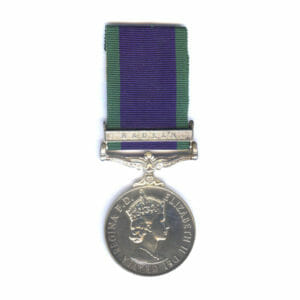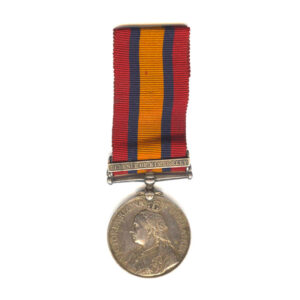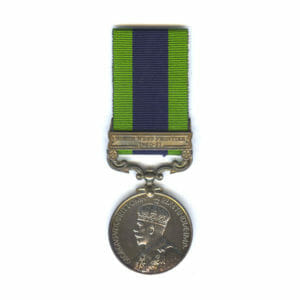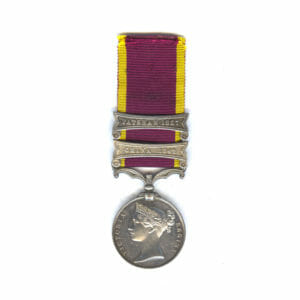Description
Waterloo Medal, contemporarily renamed to G. Jones, 52nd Regiment of Foot.
Contemporarily renamed in cross hatched lettering: “G JONES * 52nd FOOT” With original impressed stars near clip.
Naming happens to be engraved in the exact format the recipients MGS would have been named. From the evidence it seems to be a “replacement” purchased to wear alongside MGS circa 1850.
With replacement clip and contemporary split suspension ring, with very old length of sewn on silk ribbon, with attached flat silver top brooch as worn.
Photographed as worn, to display the reverse design.
The Waterloo Medal Database records that the “Drummer” George Jones of the 52nd, who earned an 11 Bar MGS, had an extremely worn and barely recognisable Waterloo Medal known to exist, which had been cast aside in a scrap box as a disc for many years. This would support the possibility that this medal was made up later as a replacement.
There were two George Jones of the 52nd Foot who fought at Waterloo, both soldiers with exceptional Peninsular services who would later claim 7 and 11 bar MGS medals.
The First George Jones, was a 25 year career Bugler who claimed an 11 Bar MGS and served in North America, Sicily, France and the Waterloo Campaign.
We have his service records which record his remarkable career.
George Jones was born circa 1788, and joined the 52nd Foot on 17th June 1805, whilst underage.
On 17th June 1806 he became of age and became a Bugler, which he would remain as for almost 25 years.
He served: 18 months in Sicily, nearly 6 years in the Peninsula, and about 2 years in North America, he was present in the Battles and Sieges of Vimiera, Busaco, Funtes D’Onor, Ciudad Rodrigo, Badajoz, Salamanca, Vittoria, Nivelle, Orthes, Toulouse, Waterloo.
According to his own statement which appears to be confirmed by the Muster Rolls, he was Twice slightly wounded.”
He was discharged in 1830, thoroughly worn out from a lifetime of campaigning on 30th January 1830.
The second George Jones, was a Waterloo Veteran who had also served in the Peninsular Wars, later claiming a 7 Bar Medal, including Badajoz, Salamanca, Vittoria, Pyrenees, Nivelle, Orthes, Toulouse.
He later claimed a late pension in WO 116/77 for a “Bayonet Wound Side Bad.”









